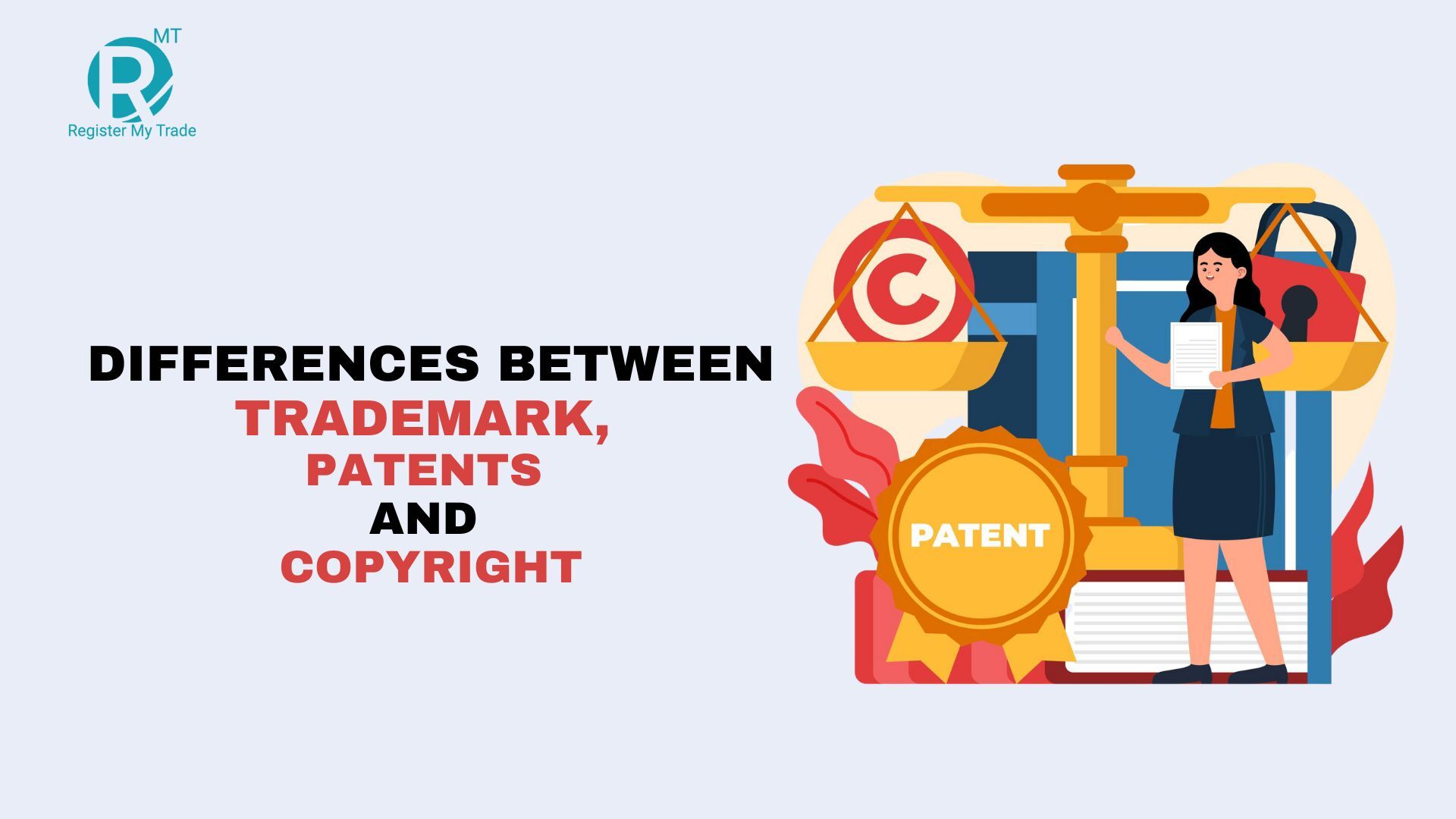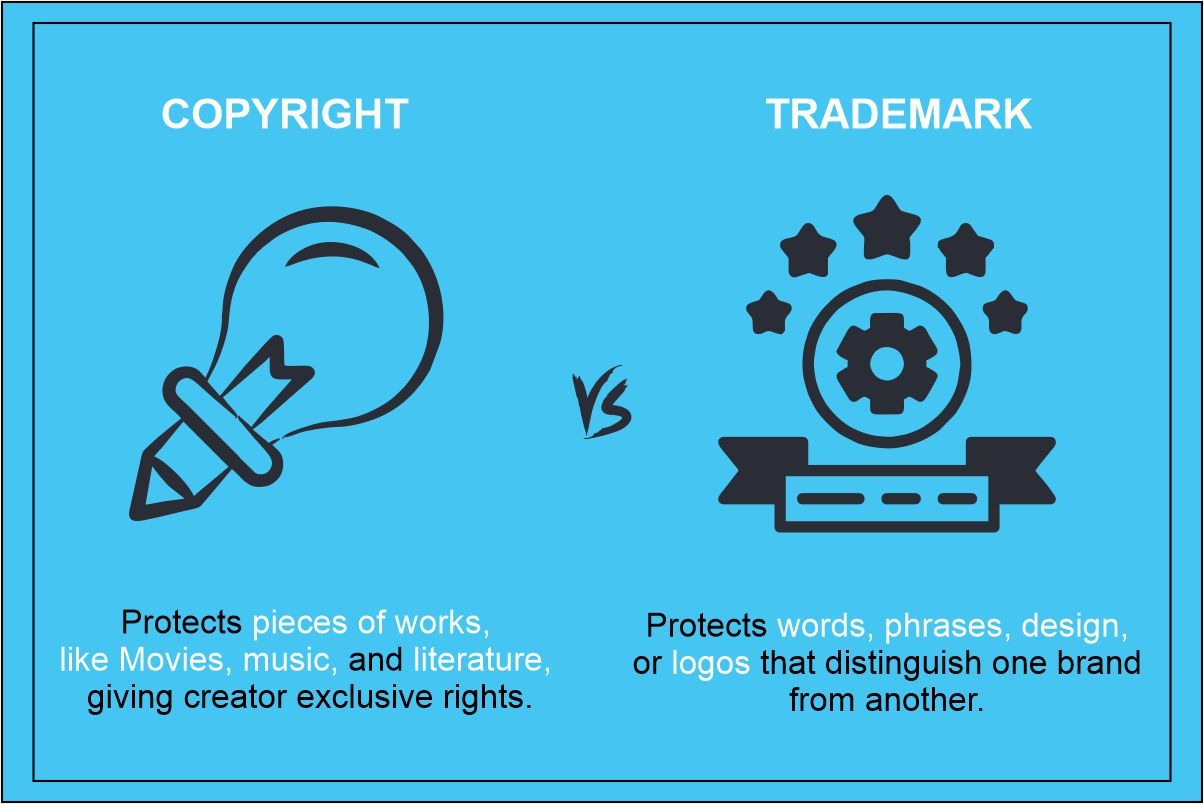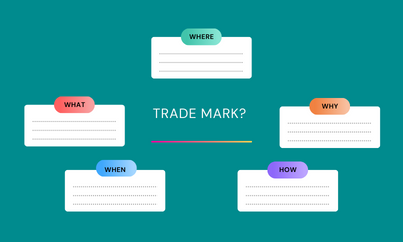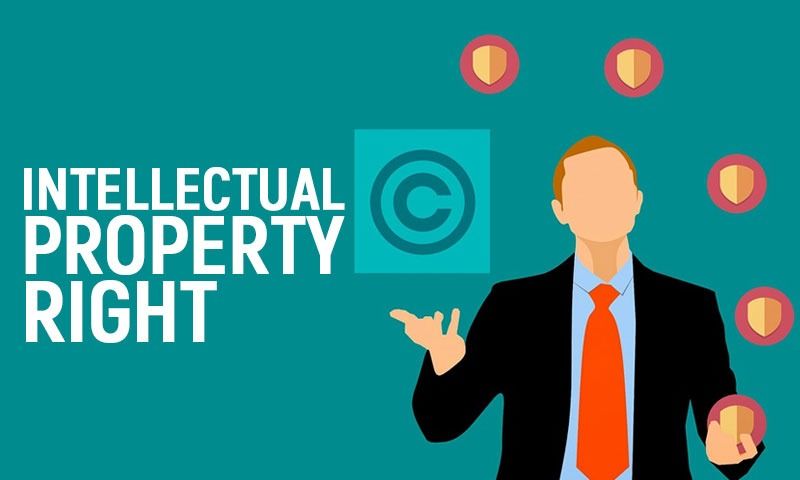When it comes to safeguarding your intellectual property, trademark registration, and copyright registration are the…

Introduction Intellectual Property Rights
The legal ownership of intangible assets, such as inventions, literary and artistic works, designs, symbols, and images, is referred to as intellectual property rights (IPR).
IPR enables owners and producers to have the only authority over any financial benefit from their works, preventing unauthorized use or duplication.
This idea is crucial because it promotes creativity and invention, which can result in economic progress…
What is the Intellectual Property Rights Act?
The Intellectual Property Rights Act (IPRA) is a comprehensive legislation that provides legal protection for intellectual property in India.
The Act was passed in 2008 and came into force on June 15, 2017. The Act aims to provide an effective legal framework for the protection and enforcement of IP rights in India and to align Indian IP laws with international best practices.
The IPRA covers a wide range of intellectual property rights, including patents, trademarks, copyrights, industrial designs, geographical indications, and trade secrets.
The Act sets out the procedures for registration, maintenance, and enforcement of these rights and provides for the creation of special courts to adjudicate IP disputes.
Key Provisions of the Intellectual Property Rights Act
Patents: The IPRA provides for the grant of patents for inventions that are new, non-obvious, and capable of industrial application.
The Act sets out the procedures for filing and prosecuting patent applications, as well as the grounds for opposition and revocation of patents. The term of a patent is 20 years from the date of filing.
Trademarks: The IPRA provides for the registration of trademarks, service marks, and collective marks. The Act sets out the procedures for registration, maintenance, and renewal of trademarks, as well as the grounds for opposition and cancellation of trademarks. The term of trademark registration is ten years, renewable indefinitely.
Copyrights: The IPRA provides for the protection of original literary, artistic, musical, and dramatic works, as well as computer programs, sound recordings, and cinematographic films.
The Act sets out the procedures for registration, ownership, and enforcement of copyrights, as well as the limitations and exceptions to copyright protection. The term of a copyright is the lifetime of the author plus 60 years.
Industrial Designs: The IPRA provides for the registration of new and original designs that are applied to articles of manufacture. The Act sets out the procedures for registration, maintenance, and enforcement of industrial designs, as well as the grounds for cancellation of design registrations. The term of an industrial design registration is ten years, renewable for up to five years.
Geographical Indications: The IPRA provides for the registration and protection of geographical indications, which are indications that identify a good as originating from a particular territory, region, or locality.
The Act sets out the procedures for registration, ownership, and enforcement of geographical indications, as well as the grounds for cancellation of geographical indications.
Trade Secrets: The IPRA provides for the protection of confidential business information, including formulas, processes, designs, and customer lists, as well as any other information that is not generally known or readily ascertainable.
The Act sets out the procedures for the protection and enforcement of trade secrets, as well as the grounds for infringement and damages.
Impact of the Intellectual Property Rights Act
The Intellectual Property Rights Act has had a significant impact on various stakeholders, including inventors, creators, businesses, and consumers.
The Act has strengthened the legal framework for the protection and enforcement of IP rights in India and has brought Indian IP laws in line with international best practices.
For inventors and creators, the Act has provided greater certainty and protection for their intellectual property, which has encouraged innovation and creativity. The Act has also made it easier for them to enforce their rights and obtain compensation for infringement.
Importance of Intellectual Property Rights
IPR plays a crucial role in promoting innovation and creativity. Without IPR, creators and inventors may not have the financial incentive to invest time and resources in developing new ideas, inventions, and creative works.
IPR provides a legal framework for protecting and monetizing intangible assets, which in turn can lead to economic growth and job creation.
In addition, IPR is important for consumers, as it ensures that they receive high-quality goods and services. Trademark protection, for example, helps consumers identify and distinguish products and services from one another, and ensures that they receive the products they expect to receive.
Issues in Intellectual Property Rights
Intellectual property rights (IPRs) are crucial in protecting creativity and innovation in today’s digital age. IPRs provide creators with exclusive rights to their products or ideas, allowing them to prevent others from using, copying, or selling their works without permission.
However, there are several issues in intellectual property rights that pose a challenge to creators and businesses. Some of the issues and the steps that can be taken to address them:-
- Online Piracy
The rise of the internet and digital technologies has made it easier for people to access and share information. However, it has also made it easier for individuals to infringe on IPRs.
Online piracy of copyrighted materials, such as movies, music, and software, is a major issue that affects content creators and distributors. Piracy not only leads to financial losses but also affects the reputation of creators.
To address online piracy, creators can use Digital Rights Management (DRM) technologies to protect their digital content. DRM technologies prevent unauthorized copying and distribution of copyrighted materials.
However, DRM technologies are not foolproof and can be circumvented by determined hackers. Creators can also take legal action against infringers.
The Digital Millennium Copyright Act (DMCA) provides legal protection for copyrighted materials and allows copyright owners to request that internet service providers (ISPs) remove infringing content from their websites.
- Patent Trolls
Patent trolls are individuals or companies that hold patents without any intention of using them. They often sue other companies for patent infringement, causing financial losses and wasting valuable time and resources. Patent trolls abuse the patent system and hinder innovation.
To address the issue of patent trolls, several measures have been proposed. These include requiring patent holders to provide evidence of actual use or plans to use the patent, limiting the scope of patents, and increasing the transparency of patent ownership.
- Counterfeit Goods
Counterfeit products are illegal copies of branded products and are sold at a lower price than the original. This not only affects the revenue of the original creators but also poses a risk to consumers as these products are often of inferior quality.
To address the issue of counterfeit goods, governments, and businesses can take several steps. Governments can increase the penalties for counterfeiting and improve border control measures to prevent the import of counterfeit products.
Businesses can use authentication technologies, such as holograms or serial numbers, to distinguish their products from counterfeits. They can also collaborate with law enforcement agencies to crack down on counterfeiters.
- Trademark Infringement
Trademarks are symbols, designs, or words used to distinguish one company’s products or services from another. The unauthorized use of a trademark by another company can lead to customer confusion and damage the reputation of the original company.
To address the issue of trademark infringement, companies can register their trademarks with the relevant authorities.
For example, in the US, companies can register their trademarks with the United States Patent and Trademark Office (USPTO). Registering trademarks provides legal protection and enables owners to take legal action against infringers.
- Copyright Infringement
Copyright infringement is a major issue that affects creators and businesses. It occurs when someone uses, reproduces, or distributes copyrighted material without permission from the copyright owner.
To address the issue of copyright infringement, creators can register their works with the relevant authorities. For example, in the US, creators can register their works with the United States Copyright Office.
Registering works provides legal protection and enables owners to take legal action against infringers. Creators can also use Creative Commons licenses, which allow them to share their works under certain conditions, such as requiring attribution or prohibiting commercial use.
Need For IPR
Firstly, intellectual property rights provide a legal framework for protecting the fruits of creativity and innovation. Without such protection, inventors and creators may be discouraged from investing their time, money, and effort into developing new products, processes, or artistic works.
For instance, if someone spends years inventing a new technology, they would be less likely to do so if their invention can be copied and exploited by others without any compensation.
By protecting their intellectual property, inventors and creators can have the confidence to invest in research and development, knowing that their work will be protected by law.
Secondly, intellectual property rights foster economic growth and competitiveness. Strong intellectual property protection encourages innovation, which in turn leads to the creation of new products, processes, and industries.
When inventors and creators know that they can profit from their work, they are more likely to invest in innovation, which results in job creation, economic growth, and increased competitiveness.
For instance, the pharmaceutical industry invests billions of dollars in research and development every year, knowing that their investment will be protected by patents.
This investment has led to the discovery of life-saving drugs and the growth of the pharmaceutical industry, which is a major contributor to the global economy.
Thirdly, intellectual property rights protect consumers and society at large. Counterfeit and pirated goods can be dangerous and harmful to consumers, as they are often of poor quality and do not meet safety standards.
Intellectual property rights ensure that only authorized parties can produce and sell products and services, which helps to ensure their safety and quality.
Additionally, intellectual property rights protect cultural heritage and traditional knowledge, which are often exploited without compensation by outside entities.
Finally, intellectual property rights play a vital role in promoting innovation and creativity in the digital age. As the world becomes increasingly digital, the need for strong intellectual property protection has become more pressing.
In the digital world, it is easy to copy and distribute copyrighted works without permission, which can have a devastating impact on the creators of those works.
Intellectual property rights provide a legal framework for protecting digital content and ensuring that creators are fairly compensated for their work.
This is essential for the continued growth and development of the creative industries, which are major contributors to the global economy.
WTO and Intellectual Property Rights in Business Law: An Overview
The World Trade Organization (WTO) is an international organization that oversees the global trading system and sets the rules for international trade.
One of the key areas of focus for the WTO is the protection and enforcement of intellectual property rights (IPR) in business law. In this article, we will discuss the role of the WTO in IPR and its impact on business law.
- TRIPS Agreement
The Agreement on Trade-Related Aspects of Intellectual Property Rights (TRIPS) is a WTO agreement that sets minimum standards for the protection and enforcement of IPR.
The TRIPS Agreement covers various forms of IPR, including patents, trademarks, copyrights, and trade secrets. The agreement requires WTO member countries to provide effective legal protection for IPR and to enforce those rights.
- Impact on Business Law
The TRIPS Agreement has had a significant impact on business law, particularly in the areas of international trade and competition.
The agreement has created a level playing field for businesses operating in different countries, ensuring that they are subject to the same minimum standards of IPR protection and enforcement.
This has helped to reduce the risk of IP infringement and counterfeiting, which can harm businesses’ reputations and profits.
- Access to Medicines
One of the most controversial aspects of the TRIPS Agreement is its impact on access to medicines. The agreement requires WTO member countries to provide patent protection for pharmaceutical products, which can make them more expensive and less accessible to people in developing countries.
However, the TRIPS Agreement also includes flexibilities that allow countries to issue compulsory licenses for essential medicines in cases of public health emergencies.
- Dispute Settlement Mechanism
The WTO has a dispute settlement mechanism that allows member countries to resolve disputes related to IPR and other trade issues.
This mechanism provides a forum for businesses and governments to resolve conflicts related to IP infringement, counterfeiting, and other issues that may arise in the context of international trade.
- Future Developments
The WTO continues to play a critical role in the development of IPR in business law. As technology continues to advance, new forms of IPR may emerge, and the WTO will need to adapt to ensure that businesses are adequately protected.
In addition, the TRIPS Agreement is periodically reviewed to ensure that it remains relevant and effective in the changing global economic landscape.
WTO plays a critical role in the protection and enforcement of IPR in business law. The TRIPS Agreement sets minimum standards for IPR protection and enforcement, creating a level playing field for businesses operating in different countries.
The WTO’s dispute settlement mechanism provides a forum for resolving conflicts related to IP infringement and other trade issues.
As technology continues to advance and new forms of IPR emerge, the WTO will continue to play an important role in ensuring that businesses are adequately protected.
International intellectual property rights refer to the legal frameworks and agreements that govern the protection and enforcement of intellectual property across national borders.
This article provides an overview of international intellectual property rights, their importance, and the challenges they present.
Why do International Intellectual Property Rights Matter?
International intellectual property rights are essential for a variety of reasons. First, they promote innovation and creativity by providing inventors, creators, and entrepreneurs with exclusive rights to their creations.
Without these rights, there would be little incentive to invest time and resources into developing new ideas or products. Second, international intellectual property rights facilitate trade and investment by providing a framework for protecting and enforcing IP across borders.
This is particularly important for industries that rely heavily on intellectual property, such as pharmaceuticals, software, and entertainment.
Third, international intellectual property rights help to safeguard public health and safety by ensuring that medicines, food, and other products are safe and effective.
International Intellectual Property Rights Agreements
There are several international agreements that govern the protection and enforcement of intellectual property rights across borders. The most important of these agreements are:
- The World Intellectual Property Organization (WIPO) administers several treaties and conventions that set standards for the protection of intellectual property at the international level. The most significant of these is the Agreement on Trade-Related Aspects of Intellectual Property Rights (TRIPS), which requires all World Trade Organization (WTO) members to provide minimum standards of IP protection.
- The Paris Convention for the Protection of Industrial Property, which was first signed in 1883 and has been revised several times since then, provides for the protection of industrial property, including patents, trademarks, and industrial designs.
- The Berne Convention for the Protection of Literary and Artistic Works, which was first signed in 1886 and has also been revised several times, provides for the protection of literary and artistic works, including books, music, and films.
- The Patent Cooperation Treaty (PCT), administered by WIPO, provides a streamlined process for filing patent applications in multiple countries.
- The Madrid System for the International Registration of Marks, also administered by WIPO, allows trademark owners to protect their marks in multiple countries through a single application process.
Challenges in International Intellectual Property Rights
Despite the existence of these international agreements, there are several challenges in the protection and enforcement of intellectual property rights across borders.
One of the most significant challenges is the differences in legal systems and standards across countries. For example, some countries may not provide the same level of protection for certain types of intellectual property or may have different rules for the duration of protection.
This can lead to confusion and uncertainty for businesses and individuals seeking to protect their intellectual property in multiple countries.
Intellectual Property Rights in business law and why they are important.
- Protection of Innovations and Creations
One of the most important roles of intellectual property rights in business law is the protection of innovations and creations.
Patents, trademarks, copyrights, and other forms of IPR provide inventors and creators with exclusive rights to their creations, allowing them to prevent others from using or copying their ideas without permission.
This exclusivity helps businesses to profit from their innovations and maintain a competitive edge in the market.
- Enhancing the Value of the Business
Intellectual property rights also enhance the value of a business. Patents, trademarks, and copyrights can be valuable assets that businesses can use to secure financing, attract investors, and increase the value of the company.
Intellectual property rights can also be used to create licensing and partnership agreements that generate revenue for the business.
- Preventing Infringement and Counterfeiting
Another role of intellectual property rights in business law is to prevent infringement and counterfeiting. Counterfeit products and infringement can harm a business’s reputation and profits.
IPR provides businesses with legal tools to enforce their exclusive rights, take legal action against infringers, and prevent others from infringing on their IP.
- International Trade and Competition
Intellectual property rights also play a significant role in international trade and competition. The protection and enforcement of IPR are crucial for businesses that engage in international trade and compete in the global market. International treaties and agreements, such as the Agreement on Trade-Related Aspects of Intellectual Property Rights (TRIPS), provide minimum standards for the protection of IPR, ensuring that businesses can compete on a level playing field.
- Innovation and Economic Growth
Finally, intellectual property rights play a significant role in fostering innovation and economic growth. IPR provides inventors and creators with the incentive to develop new ideas and products, knowing that they will be able to profit from their innovations.
This incentivizes investment in research and development, leading to the creation of new industries and products, and ultimately contributing to economic growth.
In the cutthroat business environment of today, it is crucial to safeguard your brand’s identity and set it apart from rival products.
An important first step in attaining this objective is trademark registration. We will discuss the trademark registration procedure, its advantages, and the actions a business owner can do to protect their brand in this post.
What Is a Trademark?
A trademark is a term, symbol, or phrase used to identify and separate the source of one party’s goods or services from those of other parties.
A trademark makes it simpler for customers to recognize and remember a company’s goods or services, which increases brand recognition and loyalty. Additionally, it distinguishes a company from its rivals, making it simpler for customers to select its goods or services.
As you can see what is trademark Class and how it is classified?
Why Register a Trademark?
- For business owners, trademark registration offers a number of advantages. Among the most significant ones are:
- Legal Protection: Registering a trademark gives your brand legal protection. It grants you the sole authority to utilize your mark in connection with your products or services, preventing others from using a mark that can lead to consumer confusion if it is similar to yours.
- Brand awareness: A trademark promotes brand loyalty and awareness. It distinguishes your company from competitors in the market, making it simpler for customers to recognize and remember your brand.
- Competitive Advantage: A registered trademark may give you a market advantage. It sets your brand apart from rivals, making it simpler for customers to select your goods or services.
- Increased Value: A trademark registration can raise the
Trademark search report
A trademark search report is an essential step in the process of trademark registration. It is a detailed report that shows the availability of a trademark for registration.
A trademark search report provides information on whether a particular trademark is already registered or pending registration.
This report is crucial for businesses looking to register their trademark, as it helps them avoid potential legal issues and protects their intellectual property rights.
A trademark search report is typically conducted by a trademark attorney or a professional trademark search firm.
The report provides information on the availability of the trademark, as well as any potential conflicts with existing trademarks.
The report includes a list of similar trademarks and their registration status, along with any potential conflicts that could arise.
The purpose of a trademark search report is to identify potential legal issues that could arise during the registration process.
If there are similar trademarks already registered, it may be challenging to register a new trademark without infringing on the rights of the existing trademark owners.
Additionally, if there are any pending applications for similar trademarks, it may be necessary to wait until those applications are either approved or rejected before proceeding with the registration process.
There are several types of trademark searches that can be conducted, including a comprehensive trademark search, a basic trademark search, and a clearance search.
A comprehensive trademark search is the most thorough and provides the most detailed information about existing trademarks.
A basic trademark search is less comprehensive and is typically used to provide a general overview of existing trademarks.
A clearance search is conducted to determine if a proposed trademark is likely to be approved for registration, based on existing trademarks and other factors.
Trademark search reports can be conducted online or in person. Online searches are typically faster and less expensive than in-person searches.
However, in-person searches may provide more detailed information and can be helpful in identifying potential issues that may not be immediately apparent in an online search.
International trademark search
An international trademark search is a process of researching and analyzing existing trademarks worldwide to determine whether a proposed trademark is available for use and registration. It is an important step for businesses that plan to expand their brand or product line into international markets.
An international trademark search helps businesses identify potential conflicts with existing trademarks in foreign markets. It is especially important for companies that operate in multiple countries or plan to expand their business to other countries.
Conducting an international trademark search can help businesses avoid legal disputes, minimize risks, and protect their intellectual property rights.

There are several ways to conduct an international trademark search. One option is to use the trademark search databases maintained by the World Intellectual Property Organization (WIPO).
WIPO is a specialized agency of the United Nations that provides services related to intellectual property rights, including trademark registration and search.
Another option is to use the services of a professional trademark search firm. These firms specialize in conducting comprehensive trademark searches in multiple jurisdictions and providing detailed reports on existing trademarks that may be similar to the proposed trademark.
When conducting an international trademark search, it is essential to consider not only the trademark itself but also the products or services that the trademark will be associated with.
Trademark infringement can occur even if the trademarks themselves are not identical, but if the goods or services are similar, the likelihood of confusion among consumers can still be high.
An international trademark search can also reveal potential language or cultural issues that may arise in foreign markets.
For example, a trademark that is acceptable in one country may have a negative connotation or be offensive in another country.
An international trademark search can help businesses avoid such issues by identifying potential cultural or linguistic sensitivities.
E-filing trademark applications
E-filing trademark applications is a process that allows individuals and businesses to submit their trademark applications electronically through the Internet. It provides a faster and more convenient way to file trademark applications compared to traditional paper filing.
E-filing trademark applications have several benefits, including:
- Convenience and Speed
E-filing allows you to submit your trademark application from anywhere, at any time, as long as you have an internet connection.
This eliminates the need for physical visits to the trademark office, saving you time and money. E-filing is also faster, as the application is processed and reviewed electronically, reducing the processing time significantly.
- Reduced Errors
E-filing significantly reduces the risk of errors as the system automatically checks for mistakes and prompts you to correct them before submission.
This helps to ensure that your application is accurate and complete, increasing your chances of success.
- Cost-Effective
E-filing is generally more cost-effective than paper filing as it eliminates the need for printing, postage, and courier costs associated with paper filing. It also reduces the chances of additional fees or penalties for errors, which can occur in paper filings.
Steps to E-file a Trademark Application:
- Conduct a Trademark Search
Before filing a trademark application, it’s important to conduct a thorough search to ensure that your proposed trademark is available and does not infringe on any existing trademarks. You can conduct a search through the Trademark Electronic Search System (TESS) on the USPTO website.
- Determine the Appropriate Trademark Class
Trademarks are classified into different categories or classes, depending on the type of goods or services they represent. It’s essential to determine the appropriate trademark class for your application to ensure that it’s correctly categorized.
- Create an Account on the USPTO Website
To file a trademark application electronically, you’ll need to create an account on the USPTO website. You can create an account by providing your personal information and verifying your email address.
- Fill out the Trademark Application
Once you’ve created an account, you can begin filling out the trademark application online. The application requires information about your proposed trademark, such as the name, description of goods or services, and the appropriate trademark class.
- Submit the Application and Pay the Filing Fee
After completing the application, you’ll need to pay the filing fee, which varies depending on the type of application and the number of classes you’re applying for. You can pay the fee electronically using a credit card or ACH payment.
- Monitor the Status of Your Application
After submitting your application, you can monitor its status online through the USPTO website. The status will show if the application is being reviewed or if there are any issues that need to be addressed.
A trademark attorney is a legal professional who specializes in trademarks and intellectual property law. They provide legal advice and guidance to individuals and businesses regarding the protection of their trademarks, from the initial registration process to ongoing monitoring and enforcement.
Trademark attorneys play a vital role in helping businesses protect their brand identity and prevent others from using or copying their trademarks without permission.
Here are some of the key functions of a trademark attorney:
- Conducting Trademark Searches
One of the primary functions of a trademark attorney is to conduct comprehensive trademark searches to ensure that a proposed trademark is available for registration and use. This involves searching various trademark databases and other sources to identify any potential conflicts with existing trademarks.
- Filing Trademark Applications
Trademark attorneys also assist businesses with preparing and filing trademark applications with the relevant government office.
They ensure that the application is complete and accurate, and includes all necessary information, such as the trademark symbol, description of goods or services, and the appropriate trademark class.
- Responding to Office Actions
After filing a trademark application, it may undergo examination by the trademark office, and the attorney will respond to any office actions, which may require additional information or clarification.
They will work with their clients to ensure that the trademark application meets all necessary requirements for registration.
- Monitoring Trademark Use and Enforcement
Trademark attorneys also monitor their client’s trademarks to identify any potential infringements or unauthorized use.
They work with clients to develop enforcement strategies to protect their trademark rights and take legal action if necessary.
- Providing Legal Advice and Guidance
Trademark attorneys provide legal advice and guidance on a range of intellectual property issues, including trademark registration, licensing, and infringement.
They help businesses navigate complex legal issues and develop strategies to protect their intellectual property rights.
Benefits of Trademarks
- Legal Protection: A registered trademark provides legal protection against infringement and unauthorized use. It gives the owner the exclusive right to use the trademark and take legal action against anyone who uses it without permission.
- Brand Recognition: A trademark helps create brand recognition and awareness, which is essential for establishing a strong brand identity and attracting customers.
- Competitive Advantage: Registering a trademark provides a competitive advantage in the marketplace by distinguishing a company’s products or services from those of its competitors.
- Asset Value: A registered trademark has value as an asset and can be licensed or sold, providing additional revenue streams for the business.
Types of Trademarks
- Word Marks: A word mark is a trademark that consists of a word or combination of words. Examples include Nike, Google, and Apple.
- Design Marks: A design mark is a trademark that consists of a design or logo. Examples include the McDonald’s golden arches and the Nike swoosh.
- Combined Marks: A combined mark is a trademark that includes both a word and a design element. Examples include Coca-Cola and Pepsi.
- Collective Marks: A collective mark is a trademark that identifies the goods or services of members of an organization or group. Examples include the American Bar Association and the Screen Actors Guild.
- Certification Marks: A certification mark is a trademark that indicates that goods or services meet certain standards or qualifications. Examples include the Good Housekeeping Seal and the USDA Certified Organic label.
Eligibility for Trademarks
In order to be eligible for trademark registration, a mark must meet the following criteria:
- Distinctiveness: A mark must be distinctive and not similar to existing marks in the marketplace.
- Use in Commerce: The mark must be used in commerce or intended to be used in commerce.
- Non-Functionality: The mark must not be functional, meaning it cannot be a necessary feature of the product or service.
- Non-Descriptiveness: The mark cannot be descriptive of the goods or services it represents.
- Non-Deceptiveness: The mark must not be deceptive or misleading to consumers.
A trademark is valid for a certain period of time, typically 10 years. When the trademark is about to expire, the owner must renew it to maintain their legal rights. In this article, we will discuss the process of renewing a trademark.
Benefits of Renewing a Trademark
Renewing a trademark has several benefits, including:
- Maintaining Legal Protection: Renewing a trademark ensures that the legal protection provided by the trademark remains in effect. This means that the trademark owner can continue to prevent others from using their trademark without permission.
- Protecting Brand Identity: Renewing a trademark helps to protect the brand identity of the company. The trademark is a valuable asset and plays a crucial role in creating brand recognition and awareness. Renewing the trademark ensures that the brand identity remains intact.
- Avoiding Penalties: Failure to renew a trademark on time can result in penalties and legal issues. By renewing the trademark on time, the trademark owner can avoid these issues.
Process of Renewing a Trademark
The process of renewing a trademark involves the following steps:
- Determine the Renewal Date: The first step in renewing a trademark is to determine the renewal date. The renewal date is the date on which the trademark registration expires. The trademark owner should keep track of this date to ensure that they renew the trademark on time.
- File the Renewal Application: The trademark owner should file a renewal application with the relevant trademark office. The application should be filed before the expiration date of the trademark. The renewal application should include the trademark registration number, the name and address of the trademark owner, and any changes to the trademark, if applicable.
- Pay the Renewal Fee: The trademark owner must pay the renewal fee when filing the renewal application. The renewal fee varies depending on the jurisdiction and the type of trademark.
- Wait for Approval: Once the renewal application and fee have been submitted, the trademark office will review the application. If there are no issues, the trademark will be renewed, and the trademark owner will receive a new registration certificate.
- Update the Trademark Record: The trademark owner should update the trademark record with any changes to the trademark or the owner’s details.
WIPO Brand
The World Intellectual Property Organization (WIPO) is a specialized agency of the United Nations that works to promote and protect intellectual property (IP) rights worldwide.
WIPO is responsible for administering several international treaties related to IP, including the Madrid System for the international registration of trademarks. In this article, we will discuss WIPO’s brand and its importance in the world of IP.
What is WIPO Brand?
WIPO’s brand is the visual and verbal identity that represents the organization. The WIPO brand includes the organization’s logo, color scheme, typography, and messaging.
The WIPO brand is designed to communicate the organization’s values, mission, and services to a global audience.
WIPO’s brand is an essential component of the organization’s efforts to promote and protect intellectual property rights worldwide.
The WIPO brand represents the organization’s commitment to innovation, creativity, and the protection of intellectual property.
Importance of WIPO Brand
WIPO’s brand is essential for several reasons, including:
- Building Trust: The WIPO brand helps to build trust among stakeholders in the global intellectual property community. The WIPO brand represents the organization’s values, mission, and services, and helps to establish the organization as a trusted authority in the field of intellectual property.
- Promoting Awareness: The WIPO brand helps to promote awareness of the organization’s services and initiatives. By creating a recognizable brand, WIPO can communicate its mission and services to a global audience.
- Encouraging Engagement: The WIPO brand helps to encourage engagement with the organization’s services and initiatives. By creating a strong brand, WIPO can attract stakeholders and encourage them to participate in the organization’s programs and initiatives.
WIPO Brand Guidelines
WIPO has developed brand guidelines to ensure that the organization’s visual and verbal identity is consistent and recognizable across all communication channels.
The WIPO brand guidelines cover several aspects of the organization’s brand, including:
- Logo: The WIPO logo is the most recognizable element of the organization’s brand. The logo should be used consistently and should never be altered or distorted.
- Color Scheme: The WIPO color scheme includes the colors blue, white, and gray. These colors should be used consistently across all communication channels.
- Typography: The WIPO brand guidelines include specific instructions for typography, including the use of the Open Sans font.
- Messaging: The WIPO brand messaging should be consistent and reflect the organization’s values, mission, and services.
Patent
A patent is a form of intellectual property that gives the inventor the exclusive right to prevent others from making, using, selling, or importing an invention for a limited period of time, usually 20 years from the date of filing the patent application.
Patent registration is the process of obtaining a patent for an invention. In this article, we will discuss all aspects of patent registration, including the types of patents, the benefits of patent registration, and the steps involved in the patent registration process.

Types of Patents
There are three main types of patents:
- Utility Patents: Utility patents are the most common type of patent and cover new and useful inventions, machines, processes, and compositions of matter. Utility patents protect the functional aspects of an invention and provide the inventor with the exclusive right to prevent others from making, using, selling, or importing the invention for 20 years from the date of filing the patent application.
- Design Patents: Design patents protect the ornamental or aesthetic aspects of an invention, such as its shape, configuration, pattern, or ornamentation. Design patents provide the inventor with the exclusive right to prevent others from making, using, selling, or importing the invention for 15 years from the date of the grant.
- Plant Patents: Plant patents protect new varieties of plants that are asexually reproduced, such as through cuttings, grafting, or tissue culture. Plant patents provide the inventor with the exclusive right to prevent others from making, using, selling, or importing the plant for 20 years from the date of filing the patent application.
Benefits of Patent Registration
Patent registration provides several benefits to inventors, including:
- Exclusive Rights: Patent registration gives the inventor the exclusive right to prevent others from making, using, selling, or importing the invention for a limited period of time. This provides the inventor with a competitive advantage in the market and allows them to commercialize their invention without fear of infringement.
- Revenue Generation: Patents can be licensed, sold, or used as collateral to secure funding for the invention. This allows the inventor to generate revenue from their invention and can provide a significant return on investment.
- Protection Against Infringement: Patent registration provides the inventor with legal protection against infringement of their invention. If someone infringes on the inventor’s patent, they can take legal action to prevent the infringement and seek damages for any losses incurred.
- Increased Credibility: Patent registration can increase the credibility of the inventor and their invention. Having a patent can demonstrate to investors, partners, and customers that the invention is unique and has commercial value.
Steps in Patent Registration Process
The patent registration process involves several steps, including:
- Conducting a Patent Search: Before filing a patent application, it is important to conduct a patent search to determine if the invention is novel and non-obvious. A patent search can be conducted using online databases or through a patent attorney.
- Drafting a Patent Application: Once the patent search is complete, the next step is to draft a patent application. The patent application should include a detailed description of the invention, including its features, functions, and benefits.
- Filing the Patent Application: After the patent application is drafted, it must be filed with the appropriate patent office. The application should include all necessary forms, fees, and supporting documents.
- Patent Examination: After the patent application is filed, it will be examined by a patent examiner to determine if the invention is novel and non-obvious. The patent examiner may request additional information or amendments to the application.
- Grant of Patent: If the patent examiner determines that the invention is novel and non-obvious, the patent will be granted.
Patent law is a branch of intellectual property law that governs the creation, protection, and enforcement of patents.
A patent is a form of legal protection that gives the inventor the exclusive right to prevent others from making, using, selling, or importing an invention for a limited period of time.
In this article, we will discuss the basics of patent law, including the requirements for obtaining a patent, the types of patent infringement, and the remedies available for patent infringement.
Requirements for Obtaining a Patent
To obtain a patent, an invention must meet three main requirements:
- Novelty: The invention must be new and cannot have been disclosed or made available to the public before the filing date of the patent application.
- Non-obviousness: The invention must not be obvious to a person having ordinary skills in the relevant field of technology.
- Utility: The invention must have a useful purpose and be capable of being used in some way.
Types of Patent Infringement
There are two main types of patent infringement:
- Literal Infringement: Literal infringement occurs when someone makes, uses, sells, or imports a product that is identical to or substantially similar to the patented invention.
- Doctrine of Equivalents: The doctrine of equivalents allows a court to find infringement even if the accused product or process does not literally infringe the patent, but performs substantially the same function in substantially the same way to achieve substantially the same result as the patented invention.
Remedies for Patent Infringement
If someone infringes on a patent, the patent owner can take legal action to prevent the infringement and seek damages for any losses incurred. The following are the remedies available for patent infringement:
- Injunction: An injunction is a court order that prohibits the infringing activity, such as the sale or manufacture of a product that infringes on the patent.
- Damages: The patent owner may be entitled to monetary damages for any losses incurred as a result of the infringement, such as lost profits or a reduction in the value of the patent.
- Royalties: The patent owner may be entitled to receive ongoing royalties from the infringer for the use of the patented invention.
- Attorney’s Fees: The prevailing party in a patent infringement lawsuit may be entitled to recover their attorney’s fees and other costs associated with the litigation.
Patent Law and Innovation
Patent law plays an important role in promoting innovation by incentivizing inventors to create new and useful inventions.
By providing inventors with the exclusive right to their inventions, patents encourage investment in research and development and provide a way for inventors to profit from their creations.
However, patent law also has its limitations and can sometimes stifle innovation by allowing patents to be granted for trivial or obvious inventions or by creating barriers to entry for new competitors.
An international patent right is a form of legal protection that grants an inventor the exclusive right to prevent others from making, using, selling, or importing an invention in multiple countries.
It is governed by international patent law, which includes various international treaties and agreements that provide a framework for the protection of intellectual property rights across borders.
In this article, we will discuss the basics of international patent rights, including the requirements for obtaining an international patent, the benefits of international patent protection, and the challenges involved in obtaining and enforcing international patents.
Requirements for Obtaining an International Patent
To obtain an international patent, an inventor must first obtain a patent in their home country. The inventor can then apply for an international patent through the Patent Cooperation Treaty (PCT), which is an international agreement that provides a standardized application process for obtaining patents in multiple countries.
The PCT application includes a detailed description of the invention, including drawings and other supporting materials, as well as a list of countries in which the inventor wishes to seek patent protection.
The application is then reviewed by an international authority, which provides a report on the patentability of the invention.
Benefits of International Patent Protection
Obtaining an international patent can provide a number of benefits for inventors, including:
- Increased Market Access: An international patent allows an inventor to prevent others from making, using, or selling their invention in multiple countries, which can increase market access and revenue potential.
- Protection Against Infringement: An international patent provides the inventor with legal protection against infringement in multiple countries, which can help to prevent competitors from copying their invention.
- Licensing Opportunities: An international patent can provide an inventor with opportunities to license their invention to others in multiple countries, which can generate additional revenue streams.
Challenges Involved in Obtaining and Enforcing International Patents
Obtaining and enforcing international patents can be a complex and challenging process, due to differences in patent laws and procedures across different countries. Some of the challenges involved in obtaining and enforcing international patents include:
- Language Barriers: Patent applications and legal proceedings may be conducted in different languages, which can create communication barriers and increase the risk of misunderstandings.
- Legal Complexities: Patent laws and procedures vary widely across different countries, which can make it difficult to navigate the legal system in each country and ensure that the patent is enforceable in all relevant jurisdictions.
- Cost: Obtaining and enforcing international patents can be expensive, due to the need to hire legal professionals in each country and to comply with different legal requirements and procedures.
Patent registration is a legal process that grants inventors the exclusive right to prevent others from making, using, selling, or importing their inventions.
In order to obtain a patent, the invention must meet certain criteria that are set forth by the patent office. In this article, we will discuss the criteria for patent registration, including the requirements for novelty, non-obviousness, and utility.
Novelty
The first criterion for patent registration is novelty. This means that the invention must be new and not previously disclosed to the public.
To determine whether an invention is novel, a patent examiner will conduct a search of the prior art, which includes all existing knowledge and technology in the relevant field.
If the invention is found to be already disclosed in the prior art, it will not be considered novel and will not be eligible for patent protection.
Non-Obviousness
The second criterion for patent registration is non-obviousness. This means that the invention must not be obvious to a person having ordinary skills in the relevant field.
In other words, the invention must not be something that a skilled person in the field could have easily thought of based on existing knowledge or technology.
To determine whether an invention is non-obvious, a patent examiner will consider the level of skill in the relevant field, the amount of prior art, and other relevant factors.
Utility
The third criterion for patent registration is utility. This means that the invention must have a practical application and be useful.
To meet the utility requirement, the invention must have a specific function or purpose, and the function or purpose must be credible and achievable. In other words, the invention must be capable of providing some tangible benefit to society.
Other Requirements for Patent Registration
In addition to the criteria for novelty, non-obviousness, and utility, there are other requirements that must be met in order to obtain a patent. These include:
- Enablement: The invention must be described in enough detail to enable a person having ordinary skills in the relevant field to make and use the invention.
- Written Description: The invention must be described in a written document that is clear and concise.
- Best Mode: The inventor must disclose the best mode of practicing the invention, which means the most effective way of using the invention.
- Statutory Subject Matter: The invention must be eligible for patent protection under the law. In general, laws of nature, physical phenomena, and abstract ideas are not eligible for patent protection.
Copyright is a legal term that refers to the exclusive rights granted to creators of original works, such as literary, artistic, musical, or dramatic works.
Copyright registration is the process by which creators can obtain legal protection for their works and prevent others from using or reproducing their works without permission.
In this article, we will discuss all about copyright registration, including the benefits, eligibility criteria, and steps to follow.
Benefits of Copyright Registration
Copyright registration offers several benefits to creators, including:
- Legal Protection: Copyright registration provides legal proof that the creator is the owner of the work and has exclusive rights to use, distribute, and reproduce the work.
- Public Notice: Copyright registration makes the work publicly available in the copyright office’s database, which serves as a public notice that the work is protected by copyright.
- Ability to Sue for Infringement: Copyright registration allows the creator to sue anyone who uses or reproduces the work without permission, and seek damages for any losses incurred.
- International Protection: Copyright registration can be used as evidence of ownership in other countries, and provides protection under international copyright treaties.
Eligibility Criteria for Copyright Registration
In order to be eligible for copyright registration, a work must meet the following criteria:
- Originality: The work must be original, meaning that it must be the result of the creator’s own intellectual effort and not copied from another source.
- Fixed in a Tangible Medium: The work must be fixed in a tangible medium, meaning that it must be in a physical form that can be perceived, such as a book, manuscript, CD, or digital file.
- Creative Expression: The work must involve some degree of creativity or originality, such as a unique arrangement of words, colors, sounds, or images.
- Copyrightable Subject Matter: The work must fall into one of the categories of copyrightable subject matter, which include literary works, musical works, dramatic works, pictorial works, audiovisual works, sound recordings, and architectural works.
The Copyright Act is a federal law that provides legal protection to creators of original works, such as literary, artistic, musical, or dramatic works.
The law sets out the rights and obligations of copyright owners and users and establishes the procedures for registering and enforcing copyright.
In this article, we will discuss the Copyright Act and law, including its key provisions, the types of works protected, and the remedies available for infringement.
Key Provisions of the Copyright Act
The Copyright Act provides several key provisions for protecting original works, including:
- Exclusive Rights: Copyright owners have the exclusive right to use, distribute, and reproduce their works, and to create derivative works based on the original work.
- Registration: Creators can register their works with the U.S. Copyright Office to obtain legal protection and establish proof of ownership.
- Term of Protection: The term of copyright protection varies depending on the type of work, but generally lasts for the life of the author plus 70 years.
- Fair Use: The Copyright Act includes the doctrine of fair use, which allows limited use of copyrighted material for purposes such as criticism, comment, news reporting, teaching, scholarship, or research.
- Infringement: Copyright infringement occurs when someone uses or reproduces a copyrighted work without permission, and can result in civil or criminal penalties.
The Copyright Act of 1957 is the primary legislation governing copyright law in India. The Act was enacted on January 21, 1958, and has been amended several times since then.
The latest amendment was made in 2012 to bring the Act in compliance with the WIPO Copyright Treaty and the WIPO Performances and Phonograms Treaty.
Copyright is a legal concept that grants creators of original works exclusive rights to use and distribute their work.
The Act defines original works as literary, dramatic, musical, and artistic works, cinematographic films, and sound recordings.
Copyright protection is granted to the creators of the works for a limited period of time, after which the work enters the public domain.
The Copyright Act of 1957 provides creators with exclusive rights to reproduce, distribute, perform, and display their work in public.
The Act also provides the right to create derivative works and sell, license, or transfer these rights to others. The Act also protects the moral rights of the creators, which include the right to be credited as the author or creator of the work and the right to the integrity of the work.
Copyright Registration
While copyright protection is automatic and does not require registration, registering your copyright with the Copyright Office provides you with legal evidence of your ownership of the work.
Copyright registration also provides you with the right to sue for copyright infringement and claim damages. The Copyright Act of 1957 provides for both voluntary and mandatory registration of copyrights.

Voluntary Registration
Voluntary registration of copyright is not mandatory, but it is recommended. You can apply for copyright registration at any time during the life of the copyright, but it is advisable to register your copyright as soon as the work is created.
The registration process involves filling out an application form, paying a fee, and submitting a copy of the work for which you are seeking copyright protection.
Mandatory Registration
Under the Copyright Act of 1957, mandatory registration is required for certain categories of works before they can be published or performed in public.
These categories include cinematographic films, sound recordings, and works of foreign authors. The registration process for these works involves filling out an application form, paying a fee, and submitting a copy of the work along with a certificate of registration from the country of origin.
Copyright Infringement
Copyright infringement occurs when someone uses, reproduces, or distributes copyrighted material without the permission of the owner.
The Copyright Act of 1957 provides several remedies for copyright infringement, including injunctions, damages, and accounts of profits.
The Act also provides for criminal penalties for copyright infringement, including imprisonment and fines.
Cost of Copyright Registration
The cost of copyright registration in India depends on the type of work and the mode of registration. The fee for voluntary registration of copyright is Rs. 500 per work, while the fee for mandatory registration is Rs. 2,000 per work. The fee for expedited processing of copyright registration is Rs. 1,000 per work…
Copyright Rules
The Copyright Act of 1957 provides several rules and regulations regarding copyright, including fair use, duration of copyright protection, and compulsory licensing.
Fair use allows for the use of copyrighted material for certain purposes, such as criticism, commentary, news reporting, teaching, scholarship, or research.
The duration of copyright protection varies depending on the type of work, but it generally lasts for the life of the creator plus 60 years.
Compulsory licensing allows for the use of copyrighted material without the permission of the owner under certain circumstances, such as for the
Types of Works Protected by Copyright
The Copyright Act protects several types of original works, including:
- Literary Works: This includes books, articles, poems, and other written works.
- Artistic Works: This includes paintings, photographs, sculptures, and other visual works.
- Musical Works: This includes songs, compositions, and other musical works.
- Dramatic Works: This includes plays, screenplays, and other works for performance.
- Audiovisual Works: This includes films, videos, and other works that combine visual and audio elements.
- Sound Recordings: This includes recordings of music, speech, or other sounds.
Remedies for Copyright Infringement
Copyright infringement can result in civil or criminal penalties, including:
- Injunctions: Copyright owners can obtain injunctions to stop further infringement of their works.
- Damages: Copyright owners can seek monetary damages for any losses incurred as a result of the infringement.
- Statutory Damages: The Copyright Act provides for statutory damages, which are predetermined amounts that can be awarded for each instance of infringement, even if no actual damages are proven.
- Criminal Penalties: Copyright infringement can result in criminal penalties, including fines and imprisonment.
Copyright protection is a legal concept that grants the creator of an original work the exclusive right to use, distribute, and reproduce their work.
It is an important aspect of intellectual property law and helps to protect the rights of creators, while also promoting innovation and creativity.
In this article, we will discuss the various aspects of copyright protection, including its cost, strike, and rules.
Copyright Strike
A copyright strike is a legal action taken against someone who has used or reproduced copyrighted material without permission.
Copyright strikes are typically initiated by the copyright owner or their representative, and can result in penalties such as fines or legal action.
In some cases, repeated copyright strikes can result in the suspension or termination of a user’s account on a particular platform.
Copyright strikes are a way for copyright owners to protect their rights and enforce their exclusive rights to use, distribute, and reproduce their works.
Creators can file a copyright strike against anyone who is using their work without permission and can take legal action to enforce their rights if necessary.
Copyright Rules
There are several rules that creators should be aware of when it comes to copyright protection, including:
- Copyright Ownership: The creator of a work is generally the owner of the copyright, but in some cases, ownership may be transferred to another person or organization.
- Copyright Registration: Copyright registration is not mandatory, but it is recommended in order to establish proof of ownership and facilitate enforcement in case of infringement.
- Fair Use: Fair use is a legal doctrine that allows limited use of copyrighted material without permission for purposes such as criticism, comment, news reporting, teaching, scholarship, or research.
- Duration of Copyright Protection: The duration of copyright protection varies depending on the type of work and the country in which it is registered, but generally lasts for the life of the author plus a certain number of years.
- Copyright Infringement: Copyright infringement occurs when someone uses or reproduces a copyrighted work without permission, and can result in civil or criminal penalties.
Steps to Follow for Copyright Registration
The copyright registration process involves several steps, including:
- Identify the Work: Identify the work that you want to register for copyright, and determine the category of copyrightable subject matter to which it belongs.
- Prepare the Application: Prepare the copyright registration application, which includes the application form, a copy of the work, and the appropriate fee.
- Submit the Application: Submit the application and the fee to the U.S. Copyright Office. The application can be submitted online, by mail, or in person.
- Wait for Processing: Wait for the application to be processed, which can take several months.
- Receive the Certificate: Once the application is processed, the creator will receive a certificate of registration, which serves as legal proof of ownership and copyright protection.
Differences between Trademarks, Patents, and Copyrights
Intellectual property (IP) is a broad term that encompasses a variety of legal protections for creative works and innovations.
Three of the most common types of IP are trademarks, patents, and copyrights. While these terms are often used interchangeably, they actually refer to distinct legal protections that serve different purposes. In this article, we will explore the differences between trademarks, patents, and copyrights.

Trademarks
A trademark is a unique symbol, word, phrase, or design that identifies and distinguishes a product or service from those of other companies. Trademarks are used to create brand recognition and are an important tool for businesses to establish and protect their brand identity. Some examples of well-known trademarks include the Nike “swoosh,” the McDonald’s golden arches, and the Coca-Cola logo.
Trademarks are registered with the government and are protected under trademark law. To be eligible for trademark protection, a mark must be distinctive and must not be too similar to an existing mark. Once a trademark is registered, the owner has the exclusive right to use the mark in connection with the goods or services for which it is registered.
Patents
A patent is a legal protection for an invention that provides the inventor with the exclusive right to make, use, and sell the invention for a certain period of time. Patents are used to protect innovative products or processes and are an important tool for promoting innovation and encouraging investment in research and development.
To be eligible for a patent, an invention must be new, useful, and non-obvious. Once a patent is granted, the inventor has the exclusive right to use, make, and sell the invention for a period of 20 years from the date of filing.
Patent law is complex, and there are several different types of patents, including utility patents, design patents, and plant patents. Utility patents protect new and useful processes, machines, articles of manufacture, and compositions of matter, while design patents protect ornamental designs for useful articles. Plant patents protect new and distinct varieties of plants that have been asexually reproduced.
Copyrights
A copyright is a legal protection for creative works, such as books, music, films, and artwork. Copyright law gives the creator of a work the exclusive right to use, distribute, and reproduce the work for a certain period of time.
Copyright protection is automatic, and a work does not need to be registered in order to be protected. However, registration is recommended, as it provides proof of ownership and facilitates enforcement in case of infringement.
Copyright law is complex, and there are several important rules and exceptions to be aware of. For example, the doctrine of fair use allows limited use of copyrighted material without permission for purposes such as criticism, comment, news reporting, teaching, scholarship, or research. Additionally, works created by the U.S. government are not subject to copyright protection.
While trademarks, patents, and copyrights are all forms of IP protection, they serve different purposes and have different requirements.
One of the key differences between trademarks and patents is that trademarks are used to protect brand identity, while patents are used to protect innovations. Trademarks are relatively easy to obtain, while patents are more complex and expensive to obtain. Additionally, trademarks last indefinitely as long as they are in use, while patents have a limited duration of 20 years from the date of filing.
Copyrights, on the other hand, protect creative works and do not require registration in order to be protected. Copyright protection lasts for the life of the creator plus a certain number of years, which varies depending on the country in which the work was created.
Udyam Registration
Udyam Registration is a scheme launched by the Government of India for the registration of micro, small, and medium enterprises (MSMEs). It is a voluntary registration process that provides a unique identification number to the businesses that register under this scheme.
The Udyam Registration is aimed at promoting the growth and development of MSMEs in India by providing them with various benefits, including easier access to credit, subsidies, and government schemes. In this article, we will discuss the eligibility criteria, registration process, benefits, and renewal process of Udyam Registration.

When to apply for Udyam Registration?
Small businesses that meet the eligibility criteria for Udyam Registration should apply for this certification as soon as possible. This certification can be obtained at any time during the year, and there is no deadline for registration.
However, it is recommended that businesses apply for Udyam Registration before commencing operations. This will ensure that they are recognized as a certified small business from the very beginning of their operations
Eligibility Criteria
The eligibility criteria for Udyam Registration are as follows:
- Business Type: Only micro, small, and medium enterprises are eligible to apply for Udyam Registration. The definition of MSMEs has been revised as per the Gazette notification of 1st June 2020. The new definition is based on the investment made by the enterprise in plant and machinery or equipment.
- Investment: The investment limit for micro-enterprises is up to Rs.1 crore. For small enterprises, the investment limit is between Rs.1 crore and Rs.10 crore. For medium enterprises, the investment limit is between Rs.10 crore and Rs.50 crore.
- Turnover: The turnover limit for micro-enterprises is up to Rs.5 crore. For small enterprises, the turnover limit is between Rs.5 crore and Rs.50 crore. For medium enterprises, the turnover limit is between Rs.50 crore and Rs.250 crore.
Registration Process
The registration process for Udyam Registration is as follows:
- Visit the Udyam Registration website: The first step in the registration process is to visit the official website of Udyam Registration.
- Enter the details: The next step is to enter the details of the business, including the name, PAN, Aadhaar number, and other relevant details.
- Self-declaration: The business owner needs to self-declare the investment and turnover of the enterprise.
- Verification: The details entered by the business owner are verified by the government through the Aadhaar number.
- Registration Number: Once the verification is complete, the Udyam Registration Number is issued to the business.
Who should apply for Udyam Registration?
Any business that meets the following eligibility criteria can apply for Udyam Registration:
- Micro or Small Enterprises: Businesses that have an investment of up to Rs. 1 crore and a turnover of up to Rs. 5 crores are classified as micro-enterprises. Businesses with an investment of up to Rs. 10 crores and a turnover of up to Rs. 50 crores are classified as small enterprises.
- Proprietorship, Partnership, or Hindu Undivided Family (HUF): Businesses that are registered as a proprietorship, partnerships, or HUF can apply for Udyam Registration.
- Limited Liability Partnership (LLP) or Private Limited Company (PLC): LLPs and PLCs that meet the above-mentioned investment and turnover criteria can also apply for Udyam Registration.
- Goods and Services Tax Identification Number (GSTIN): Businesses that have a GSTIN can apply for Udyam Registration.
Benefits
The benefits of Udyam Registration are as follows:
- Easy access to credit: Udyam Registration makes it easier for MSMEs to access credit from banks and financial institutions. It also helps in getting loans at lower interest rates.
- Subsidies: MSMEs registered under Udyam Registration are eligible for various subsidies provided by the government.
- Tendering: MSMEs registered under Udyam Registration are given preference in government tendering processes.
- Protection: MSMEs registered under Udyam Registration are protected under the Micro, Small, and Medium Enterprises Development Act, 2006.
Renewal Process
The renewal process for Udyam Registration is as follows:
- Visit the Udyam Registration website: The first step in the renewal process is to visit the official website of Udyam Registration.
- Enter the Udyam Registration Number: The business owner needs to enter the Udyam Registration Number to initiate the renewal process.
- Verification: The details entered by the business owner are verified by the government through the Aadhaar number.
- Update the details: If there are any changes in the investment or turnover of the enterprise, the business owner needs to update the details.
- Renewal: Once the verification and updation of details are complete, the Udyam Registration is renewed for another year.
Business Registration Number
Having a business registration number is crucial for any business entity, be it a sole proprietorship, partnership, limited liability partnership (LLP), or a private limited company.
The registration number is a unique identification number assigned by the respective authority to the business entity at the time of registration. In this article, we will explore what a business registration number is, why it is important, and the process of obtaining one.

What is a Business Registration Number?
A business registration number is a unique identification number that is assigned to a business entity when it is registered with the respective authority.
The registration number is used by the government and other agencies to identify the business entity, its owners, and its activities. The number is unique to each business entity and is used to differentiate one business from another.
In India, the business registration number is commonly known as the GSTIN (Goods and Services Tax Identification Number).
It is a 15-digit alphanumeric code that is assigned to businesses that are registered under the Goods and Services Tax (GST) regime.
The GSTIN is used to identify businesses for the purpose of taxation, and it is mandatory for businesses with an annual turnover of over Rs. 20 lakhs (Rs. 10 lakhs for businesses in special category states) to register for GST and obtain a GSTIN.
Why is a Business Registration Number Important?
A business registration number is important for several reasons. Firstly, it is a legal requirement for businesses to obtain a registration number.
Failing to do so can result in penalties and legal action. Secondly, the registration number is used to identify the business entity for the purpose of taxation.
Without a registration number, it would be difficult for the government to track the business’s transactions and ensure compliance with tax laws.
In addition to these legal and regulatory reasons, having a business registration number can also provide several benefits to the business.
For example, it can enhance the business’s credibility and reputation, as it shows that the business is registered and legitimate.
It can also make it easier for the business to obtain loans and credit, as lenders and financial institutions often require proof of registration before extending credit.
Process of Obtaining a Business Registration Number
The process of obtaining a business registration number varies depending on the type of business entity and the applicable laws and regulations. In general, the process involves the following steps:
- Choose the Type of Business Entity: The first step in obtaining a business registration number is to choose the type of business entity. The most common types of business entities in India are sole proprietorship, partnership, LLP, and private limited company.
- Obtain Necessary Licenses and Permits: Depending on the nature of the business, certain licenses and permits may be required before registration can take place. For example, businesses involved in food processing or manufacturing may require a food license, while those involved in import/export may require an import/export license.
- Register with the Appropriate Authority: Once all necessary licenses and permits have been obtained, the business entity must be registered with the appropriate authority. The registration process will vary depending on the type of business entity and the applicable laws and regulations.
- Obtain the Business Registration Number: After the registration process is complete, the business registration number will be assigned by the respective authority. The number must be used in all business transactions and filings going forward.
Renewal of Business Registration Number
Once a business registration number has been obtained, it is important to ensure that it is renewed on a regular basis.
The renewal process will vary depending on the type of business entity and the applicable laws and regulations. In general, businesses must file annual returns and pay any applicable fees or taxes to keep their registration number active.
Geographical Indication Registration
Geographical Indication (GI) is a legal term used to recognize and protect the distinctiveness and quality of a product originating from a specific geographic region.
The registration of Geographical Indication provides legal protection for the unique qualities and characteristics of a product that are derived from its geographical origin. This article will discuss the concept of Geographical Indication Registration, its benefits, and the registration process.

What is Geographical Indication Registration?
Geographical Indication Registration is a legal process that protects the unique characteristics and qualities of a product that are linked to its geographical origin.
It is a type of intellectual property protection that ensures that the name or sign that identifies the origin of a product is not used by others to promote their products.
In India, Geographical Indication Registration is governed by the Geographical Indications of Goods (Registration and Protection) Act, of 1999.
The registration process is administered by the Geographical Indication Registry, which is located in Chennai, Tamil Nadu.
Benefits of Geographical Indication Registration
Geographical Indication Registration provides various benefits to the producers of products that are associated with a specific geographical region. Some of these benefits are:
- Protection: Geographical Indication Registration provides legal protection to the unique qualities and characteristics of a product that are derived from its geographical origin. This protection helps prevent the misuse of the name or sign that identifies the origin of the product.
- Recognition: Geographical Indication Registration provides recognition to the producers of the product for their efforts in maintaining the unique characteristics and qualities of the product. This recognition can help increase the value of the product in the market.
- Economic Benefits: Geographical Indication Registration can provide economic benefits to the producers of the product by increasing the demand and value of the product in the market. This can lead to increased profits for the producers and contribute to the overall economic development of the region.
- Promotion: Geographical Indication Registration can help promote the product and the region associated with it. This can attract tourists and help in the development of the tourism industry in the region.
Who can apply for Geographical Indication Registration?
Any person or group of persons who produce a product that is associated with a specific geographical region can apply for Geographical Indication Registration.
The applicant must be a representative of the producers of the product and must be able to show that the product has unique qualities and characteristics that are derived from its geographical origin.
The following are some examples of products that can be registered under Geographical Indication:
- Agricultural Products: Agricultural products such as fruits, vegetables, spices, grains, and cereals can be registered under Geographical Indication.
- Handicrafts: Handicrafts such as carpets, pottery, and textiles that are produced using traditional methods can be registered under Geographical Indication.
- Industrial Products: Industrial products such as machinery, tools, and equipment that are produced in a specific geographical region can be registered under Geographical Indication.
The registration process for geographical indications can be a bit complicated, but it is essential to follow the correct steps to ensure the protection and authenticity of the product. In this article, we will discuss the geographical indication registration process and renewal in detail.
Geographical Indication Registration Process:
- Determine the Eligibility: The first step is to determine whether the product is eligible for GI registration or not. The product must be associated with a specific geographical area, and its quality, reputation, and other characteristics must be mainly due to its origin.
- Form a GI Association: A group of producers, farmers, or other stakeholders from a particular geographical area must form a GI association. The association will be responsible for managing the GI registration process and protecting the interests of the producers.
- File the Application: The GI association must file an application for registration of the geographical indication with the Registrar of Geographical Indications. The application must contain all the necessary information about the product, the geographical area, and the GI association.
- Examination of Application: The Registrar will examine the application to ensure that it meets all the requirements for GI registration. If the application is incomplete or incorrect, the Registrar may ask for additional information or clarification.
- Publication: If the Registrar is satisfied with the application, it will be published in the Geographical Indication Journal. The purpose of the publication is to invite any objections to the registration of the geographical indication.
- Objection Period: Any person may file an objection to the registration of the geographical indication within three months of the publication of the application. If there is no objection or if the Registrar rejects the objection, the geographical indication will be registered.
- Registration: If there is no objection, or if the Registrar rejects the objection, the geographical indication will be registered, and the GI association will be issued a certificate of registration. The certificate is valid for ten years, after which it must be renewed.
Geographical Indication Renewal:
The registration of a geographical indication is valid for ten years, after which it must be renewed to maintain its protection.
The renewal process is relatively straightforward and can be done by following these steps:
- Application: The GI association must file an application for renewal with the Registrar of Geographical Indications before the expiration of the current registration.
- Examination: The Registrar will examine the application to ensure that all the necessary documents and information have been provided.
- Renewal: If the Registrar is satisfied with the application, the geographical indication will be renewed, and the GI association will be issued a new certificate of registration. If there are any issues with the application, the Registrar may ask for additional information or clarification.
Design Registration
Design registration is a legal process that offers exclusive rights to the proprietor of the design to use it, prevent others from using it, and derive benefits from it.
A design is the outer appearance of any article that can be seen with the naked eye. It can be in the form of shape, configuration, pattern, ornament, or composition of lines or colors applied to the article.
Design registration provides legal protection to such designs, ensuring that others cannot use them without the proprietor’s consent.
Design registration is essential for businesses and individuals that have created unique designs that they want to use for their products or services.
Registering a design ensures that no one else can use it, thereby preventing any chances of duplication or imitation. It also provides a legal remedy in case of any infringement of the design rights.

Design Registration Process:
The process of design registration involves the following steps:
- Creation of Design: The first step is the creation of a unique design. It can be in any form, such as a shape, configuration, pattern, ornament, or composition of lines or colors applied to an article.
- Classification of Design: Once the design is created, it is classified into one of the 32 classes as per the Locarno Classification. It is essential to classify the design as it helps in determining the registration fees and the validity of the design.
- Filing of Application: The next step is the filing of the design registration application with the Design Wing of the Intellectual Property Office (IPO) of the country. The application must include the details of the proprietor, the design, and the class under which it is to be registered.
- Examination of Application: After the application is filed, it is examined by the Design Wing of the IPO. The examination involves checking whether the design is unique and original and whether it meets the registration requirements.
- Publication of Design: If the application is accepted, the design is published in the official gazette of the IPO. The publication is done to invite objections or opposition to the registration of the design.
- Opposition: If there are no objections or oppositions to the design, it is registered. However, if there are any objections, the Design Wing of the IPO conducts a hearing to resolve the objections.
- Registration of Design: If there are no objections or if the objections are resolved, the design is registered, and the proprietor is provided with a certificate of registration.
Design Registration Benefits:
- Exclusive Right to Use: Once a design is registered, the proprietor has the exclusive right to use it for a period of 10 years. No one else can use the design without the proprietor’s consent.
- Legal Protection: Design registration provides legal protection to the proprietor, preventing others from using the design without permission. It also provides a legal remedy in case of infringement of design rights.
- Asset Creation: A registered design is an asset that can be sold, licensed, or used as collateral for obtaining loans.
- Competitive Advantage: Design registration provides a competitive advantage to businesses, making their products or services unique and easily distinguishable from their competitors.
- Brand Building: A registered design helps in brand building and creating brand recognition among consumers.
Design Registration Renewal:
The registration of a design is valid for a period of 10 years. After the expiry of the initial period, the proprietor can renew the registration for another 5 years by paying the prescribed renewal fees.
The proprietor must file the renewal application within six months from the date of the expiry of the initial registration period.





This Post Has 0 Comments